Images
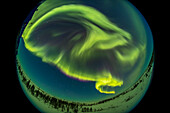
13897565 - A 360° fish-eye view of a sky-filling aurora on March 4, 2022 taken from the Churchill Northern Studies Centre, Churchill, Manitoba. This is looking north but with the lens taking in most of the sky including the zenith at top where the curtains are converging and swirling, and near the Big Dipper. Note the subtle nitrogen pink fringe along the lower curtain.

71441001 - Panorama with unique multi-layered lens clouds over a mountain in Torres del Paine National Park, Chile, Patagonia

13784441 - Lens Display In Ponce Inlet Lighthouse Museum; Daytona Beach, Florida, Usa

71026950 - Europe,France, the Louvre Museum in Lens, a statue of Venus in the center. Visitors of sides (architectes Kazuyo Sejima/Ryue Nishizawa©Sanaa)
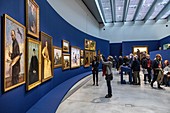
71340805 - TEMPORARY EXHIBITION ON POLAND, LOUVRE-LENS MUSEUM, LENS, PAS-DE-CALAIS, FRANCE

71340804 - MARCUS AURELIUS, ROMAN EMPEROR (161-180 AD), GALLERY OF TIME, LOUVRE-LENS MUSEUM, LENS, PAS-DE-CALAIS, FRANCE

71340803 - ROMAN ERA, GALLERY OF TIME, LOUVRE-LENS MUSEUM, LENS, PAS-DE-CALAIS, FRANCE
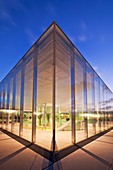
71310760 - Louvre Lens Museum, Lens, Pas-de-Calais, France, Europe
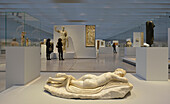
71026954 - Europe,France, the Louvre in Lens marble statue lying, (architectes Kazuyo Sejima/Ryue Nishizawa@Sanaa)
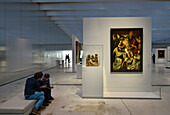
71026951 - Europe,France, scene in the exhibition hall of the Louvre in Lens (architectes Kazuyo Sejima/Ryue Nishizawa©Sanaa)
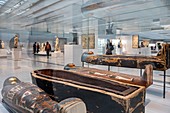
71340806 - SARCOPHAGUS OF THE LADY TANETMIT, EGYPT 945-715 AD, GALLERY OF TIME, LOUVRE-LENS MUSEUM, LENS, PAS-DE-CALAIS, FRANCE

71310759 - Louvre Lens Museum, Lens, Pas-de-Calais, France, Europe

71340807 - VISITOR IN FRON OF THE SCULPTURE OF VENUS AND LOVE STANDING ON A SEA MONSTER (CIRCA 200-300 AD), GALLERY OF TIME, LOUVRE-LENS MUSEUM, LENS, PAS-DE-CALAIS, FRANCE

71026956 - Europe,France, gateway to the Louvre Lens hall (architectes Kazuyo Sejima/Ryue Nishizawa©Sanaa)

71026955 - Europe,France, exhibition hall of the Louvre in Lens. Hermaphrodite statue in the foreground (architectes Kazuyo Sejima/Ryue Nishizawa©Sanaa)
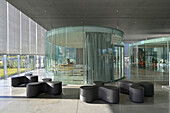
71026957 - Europe,France, gateway to the Louvre Lens hall (architectes Kazuyo Sejima/Ryue Nishizawa©Sanaa)

71026953 - Europe,France, the Louvre in Lens, vertical view of the statue of Jupiter, an eagle at his feet (architectes Kazuyo Sejima/Ryue Nishizawa©Sanaa)

71026952 - Europe,France, the Louvre Museum in Lens, exhibition hall, a stone box in the foreground (architectes Kazuyo Sejima/Ryue Nishizawa©Sanaa)
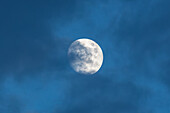
14125134 - A waxing gibbous moon with clouds photographed in the daytime with a telephoto lens over New Mexico.
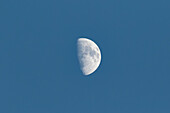
14124082 - A waxing gibbous moon photographed in the daytime with a telephoto lens over New Mexico.

14123901 - A waxing crescent moon & stars photographed at night with a telephoto lens over the Dominican Republic.
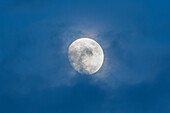
14123763 - A waxing gibbous moon with clouds photographed in the daytime with a telephoto lens over New Mexico.
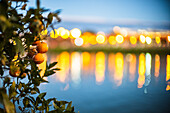
14128104 - Bitter oranges by the Guadalquivir river, Seville, Spain. Photo taken with a Leica Noctilux 50mm f/0.95 lens. wide open.

14125824 - A waxing gibbous moon with clouds photographed in the daytime with a telephoto lens over New Mexico.
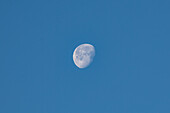
14126163 - A waning gibbous moon photographed in the daytime with a telephoto lens over Utah.
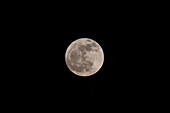
14125052 - A full moon photographed with a telephoto lens over Utah.

14124005 - A waxing gibbous moon photographed in the daytime with a telephoto lens over Utah.
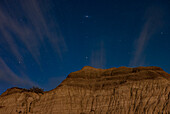
13900215 - The Andromeda Galaxy (aka Messier 31) and the stars of Andromeda rising over moonlit formations at Dinosaur Provincial Park, Alberta. Illumination is from the waxing gibbous Moon, low in the southwest so it is providing a warm light. This is an example of a "deepscape" - a nightcape with a telephoto lens to also record a deep-sky object in the frame above the horizon. However, moonlight prevents the galaxy from showing up as well as it would in a dark sky.
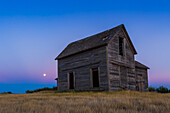
13900113 - The rising almost-Full Moon, a “Blue Moon” of July 30, 2015, rising behind a rustic old farmhouse near Bow Island, Alberta. The Moon sits in the pibk Belt of Venus with the blue shadow of the Earth below. This is a single frame from a 600-frame time-lapse sequence, taken with the Canon 6D and 16-35mm lens.
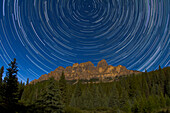
13900075 - Circumpolar stars trails over Castle Mountain in Banff, Alberta. Taken July 23, 2010 from Castle Cliffs viewpoint on Bow Valley Parkway. A stack of 160 25-second exposures with Canon 15mm lens at f/4 and Canon 7D camera at ISO 640. Taken over 2 hours. Full Moon light provided the illumination.

13900034 - A circumpolar star trail stack taken from the Table Mountain Star Party, July 26, 2014, at the Eden Valley Guest Ranch. This is a stack created from 250 frames taken for a time-lapse movie, stacked using Advanced Stacker Actions with "Elastic Stars" effect. Each frame was 45 seconds at f/2.8 with the Rokinon 14mm lens and Canon 6D at ISO 2000.

13899984 - The Very Large Array (VLA) radio telescope in New Mexico, at sunset, March 17, 2013, with the Earth shadow rising at right and the pink Belt of Venus along the eastern horizon. This is a 2-section panorama, hand-held, with the 14mm lens and Canon 60Da camera.
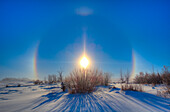
13899804 - Sundogs and a solar halo around the Sun, December 19, 2013, shot from home with the Canon 60Da and 10-22mm lens. The halo is caused by ice crystals in the air, in this case very nearby as they can be seen as "stars" sparkling in the sunlight in the sky and in the foreground. This is an HDR stack of three exposures at 2/3rds stop intervals, processed thru Photomatix Pro.
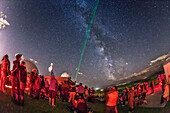
13899773 - People gaze skywards at the public stargazing session, Milky Way Night, at the Rothney Astrophysical Observatory, operated by the University of Galgary. Roland conducts the laser star tour. This was August 30, 2014. Exposure was 13 - 20 seconds at f/3.2 with the 15mm lens and Canon 6D at ISO 4000.
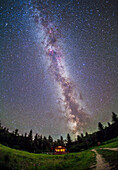
13899459 - The summer Milky Way over the Log Cabin at the Reesor Ranch, July 16, 2013. This is a stack of 5 x 4 minute tracked exposures for the sky + one 4 minute untracked exposure for the ground. Each at f/2.8 with the 15mm lens and Canon 5D MkII at ISO 1600.

13899326 - Stack of 3 x 4 min exposures at ISO 800, with 15mm Canon lens at f/4. Taken at Sask Summer Star Party, August 29, 2008. Tracked on AP Mach 1 mount.
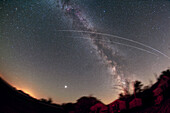
13898784 - STS128 Discovery Shuttle (lower path) and ISS (upper path) flying over about 4 minutes apart in single 10-minute tracked exposure, Sept 10, 2009, with Canon 5D MkII and 15mm lens at f/4 and at ISO200.
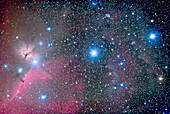
13898681 - Belt of Orion with Horsehead and Flame Nebulas. Taken Jan 19, 09 with 77mm f/4 Borg astrograph lens (300mm focal length) and Canon 20Da camera at ISO 400 for 4 x 18 minute exposures. On AP Mach 1 mount. Autoguided with SBIG ST402 camera and PHD Guider. Excellent night but lots of snow and sky was good but somewhat lit by snow illumination.
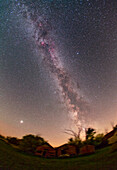
13898604 - Stack of two 6 minute exposures at ISO 400 and f/4 with 15mm lens and Canon 5DMkII camera. Taken Sept 10, 2009 with Moon just rising or about to, so sky is brighter than normal.
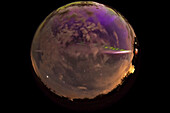
13898158 - A fish-eye lens / all-sky view of the STEVE aurora arc across the sky and in clouds on May 6, 2018, from home in southern Alberta, with a diffuse aurora to the north casting streaks of purple up the sky, and a green glow along the horizon. This night the aurora was very active to the north and east with a terrific display in Churchill, Manitoba about an hour before this, matching the usual STEVE characteristic of him appearing as a major storm subsides.
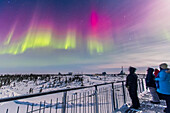
13897897 - The aurora of February 7, 2014 seen from Churchill, Manitoba at the Churchill Northern Studies Centre, in a view looking southeast over the abandoned Churchill Rocket Range, with the 10-22mm lens. This is taken from the second floor viewing deck at the CNSC. This is a 15-second exposure at f/3.5 and ISO 1600 wth the Canon 60Da camera. Jupiter and Gemini are at top and Orion at lower right. The gibbous Moon is just off the frame at upper right.
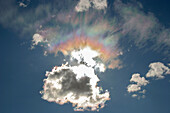
13897878 - Taken at Alberta Star Party, Sept 27, 2008 with 18-200mm lens and Canon 20Da
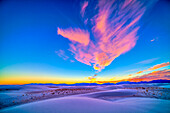
13897522 - Sunset colours over White Sands National Monument, New Mexico, December 10, 2013. Venus is at left of centre. This is an HDR (High Dynamic Range) stack of 7 exposures at 2/3 stop increments from -2 to +2 EV, processed first with ACR then with Photomatix Pro. Images taken with the 14mm Rokinon lens at f/4 and Canon 5D MkII at ISO 100. While colour vibrancy has been enhanced the colours to the eye were quite vivid. The HDR technique brings out details in the dark ground while preserving the bright sky.
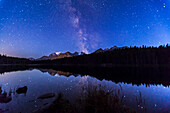
13897514 - The Milky Way over Herbert Lake, Banff, Alberta, near Lake Louise. Mount Temple is glacier-clad peak at left. A single exposure of 40 seconds at f/2.8 with 16-35mm lens and Canon 5D MkII at ISO 1600. No Moon, and taken in late twilight.
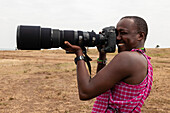
13836477 - Saruni Kisemei, a Masai field guide, taking pictures with a telephoto lens. Model Released.
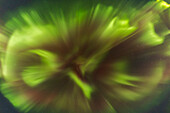
13998668 - A fish-eye lens image of auroral curtains and rays converging toward the zenith overhead at centre,with the camera looking straight up from the parking lot of the Churchill Northern Studies Centre. Taken February 19,2023. The Big Dipper is at centre.
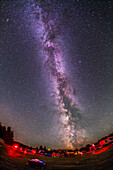
13900622 - The northern summer Milky Way over the Saskatchewan Summer Star Party in Cypress Hills, Saskatchewan, Canada, August 18, 2012. Taken with the Canon 5D MkII at ISO 800 and 15mm lens at f/4 for a stack (mean combined) of four 5 minute exposures, all tracked. The ground is from only one of those expoures (the gorund is masked out in the other layers).

13900298 - A 360° ground to zenith panorama of the Mt. Edith Cavell area from the Trail of the Glacier pathway, at the footbridge crossing Cavell Creek. I shot this at twilight, just after sunset. It is a stitch, with PTGui software, of 8 segments at 45° spacings with the 15mm full-frame fish-eye lens and Canon 6D. Each was 0.4 seconds at ISO 100 and f/4. (I should have stopped down some more!)
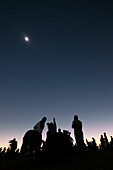
13900107 - Total Solar Eclipse, from a site 130 km south of Tobrouk, Libya; March 29, 2006. 0.8 second exposure with Canon 20D camera and 10-22mm lens at 12mm focal length and f/5 aperture. Exposure set auotmatically. Part of a time-lapse sequence with frames firing every 1s.
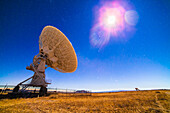
13899753 - One of the 27 antennas of the Very Large Array (VLA) radio telescope complex in New Mexico (with others in the distance at lower right) illuminated by moonlight, on December 13, 2013, peak night for the Geminid meteor shower. A single exposure of 30 seconds with the Rokinon 14mm lens at f/2.8 and Canon 5D MkII at ISO 800. Orion is rising a lower centre. The Moon is the bright object at upper right. The Pleiades and Hyades are above centre.

13899655 - The Big Dipper over Castle Mountain, Banff, on a partly cloudy and dewy night. Taken as part of a 150-frame time-lapse. With the 24mm lens and Canon 5D MkII for 30 seconds at f/2 and ISO 1600.
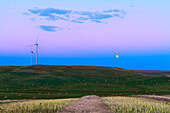
13899571 - The Full Moon of August 31, 2012 (which was a "Blue Moon" -- i.e. the second Full Moon of the month) rising over a harvested field, with windmills of the Wintering Hill wind farm. The pink Belt of Venus band is visible above the blue band above the horizon that is Earth's shadow. This is a 6-exposure HDR stack taken with the Canon 7D at ISO 100 and 16-35mm lens. Metered exposures.

13899261 - Comet Leonard (C/2021 A1) on the morning of December 10, 2021, with a 200mm telephoto lens for a field of view of 10° x 6.8°. The tail appears to be about 3.5° long here. Taken about 6:30 am MST with the comet as high as it would be, though the sky is already beginning to brighten with the blue of dawn twilight. The distinctive cyan tint of a comet's coma is prominent.
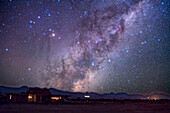
13899206 - Scorpius rising over Atacama Lodge near San Pedro de Atacama in Chile (latitude -23°). Taken in March 2010 with modified Canon 5DMkII and Sigma 50mm lens at f/2.8 for stack of 4 x 1.5 minute exposures at ISO 800. Ground is from one frame.
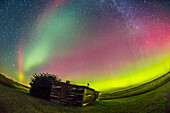
13899081 - The Northern Lights shot at the old Larson Ranch site in the Frenchman Valley at Grasslands National Park, Saskatchewan, August 27/28, 2014. The pioneer cabin was the home of the legendary western author and movie star Will James, born Ernest Dufault in Quebec. He lived in this cabin when he worked the ranches in the area. The aurora was excellent this night. This is a single 1-minute exposures at ISO 2500 with the 15mm full-frame fish-eye lens at f/3.2 and the Canon 6D.
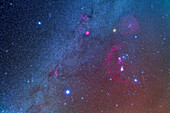
13899031 - Orion and the Winter Triangle stars, Sirius, Procyon and Betelgeuse, taken from the Painted Pony Resort in New Mexico, March 13, 2013. A stack of 5 x 8 minute exposures at f/4 with the 35mm Canon lens and 5D MkII at ISO 800, plus a layer of 2 x 8 minutes with the Kenko Softon filter for the star glows. M50, M46, M47 and M41 clusters all visible at left.
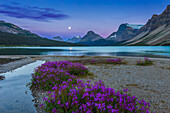
13899024 - The nearly Full Moon (0ne day before Full) rising at the end of Bow Lake, with purple flowers (Purple Saxifrage?) in the foreground. Taken August 9, 2014. This is an HDR High Dynamic Range stack of 5 exposures at 2/3rds stop intervals, with the Canon 16-35mm lens and Canon 6D at ISO 400.
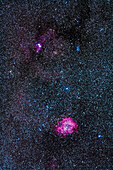
13898988 - The area of the Rosette Nebula (bottom) and Christmas Tree Cluster (top) in Monoceros with the Fornax Lightrack tracker and 200mm lens + Canon 5D MkII. The nebulosity at top includes the Cone Nebula.
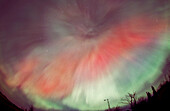
13898976 - April 17/18, 2001 aurora, taken from home in Alberta. looking south. Part of a series taken looking same direction as substorm hit and subsided, from Image #2 to #15, on Roll #1. (Roll #2 was second camera shooting Provia 100F with 28mm lens and 18mm lens.) All images in this series (#1-02 thru 15) processed in Photoshop with nearly identical enhancements to contrast and colour. Brightness toned down for longer overexposed shots (early ones).
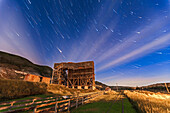
13898847 - The old Atlas Coal Mine near East Coulee, Alberta, now a museum and tourist attraction. This is a composite of 20 x 1 minute exposures with the Canon 5D MkII and 16-35mm lens at 16mm and f/2.8, and ISO 1250. Taken June 27, 2013. While the Moon was up it was in some cloud and most of the illumination of the foreground comes from a sodium vapour light just off camera at right. Images stacked with StarCircleAcademy's Advanced Stacker Actions, Comet Streaks option.
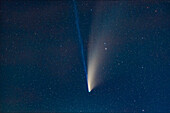
13898314 - Comet NEOWISE (C/2020 F3) in a telephoto lens close-up on July 19, 2020, showing the straight blue ion tail and the curving whitish-yellow dust tail. Even the ion tail was visible in binoculars and traceable out for 12° or so, or two binocular fields. A bit of cyan colour is visible around the head of the comet. The ninth magnitude galaxy NGC 2841 is visible to the right of the comet.
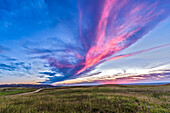
13898267 - Sunset at the Reesor Ranch, on the edge of the Cypress Hills, on the Alberta-Saskatchewan border, July 4, 2014. This is a high dynamic range stack of 6 exposures at 2/3rds stop intervals, with the Canon 60Da and 10-22mm lens.
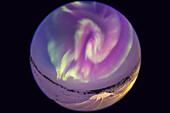
13898238 - An all-sky aurora from Churchill, Manitoba, on Feb 17, 2015, in a frame from a 250-frame time-lapse movie. Taken from the Churchill Northern Studies Centre, using an 8mm Sigma fish-eye lens on the Canon 6D for a 360° view of the sky, though with the camera titled about 25° to create an image suitable for projection in a tilted-dome digital planetarium. This a 15-second exposure at ISO 3200 and f/3.5. The temperature was about -30° C.

13898154 - Comet Leonard (C/2021 A1) on the morning of December 10, 2021, with a 135mm telephoto lens for a field of view of 10° x 15°. The tail appears to be about 4° long here. Taken about 5:45 am MST. The distinctive cyan tint of a comet's coma is prominent. The comet was in Serpens at the time.
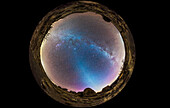
13898092 - A 360° fish-eye panorama of the evening sky, January 16, 2015, showing the Zodiacal Light rising out of the western sky and last vestiges of twilight, and the Milky Way across the sky in the east. Comet Lovejoy (C/2-14 Q2) near the Pleiades just left of centre at the top of the pyramid of light from the Zodiacal Light. A meteor appears below centre. This is a stitch of 8 segments, each taken with the 15mm lens and Canon 6D in portrait orientation, for 1 minute at ISO 3200 and f/2.8. Stitched with PTGui.
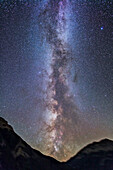
13898058 - The Milky Way from northern Sagittarius to southern Cygnus, above the mountains of Waterton Lakes National Park; Alberta, Aug 31, 2013. This is a stack of 4 x 3 minute exposures at f/2.8 with the 24mm lens and Canon 5D MkII at ISO 1600.

13897956 - Gibbous Moon over Banff townsite, Banff National Park, Alberta, Canada. Taken July 29, 2012 with Canon 7D and 10-22mm lens at ISO 100, f/6.3 and metered. Taken in twilight. Peak is left is Mt. Rundle. Taken from Mt. Norquay viewpoint overlooking town looking south.

13897879 - The aurora of February 3-4, 2014 seen from Churchill, Manitoba at the Churchill Northern Studies Centre, looking west to Orion and Taurus, with tour group members taking in the sight. This is a 2-second exposure at f/2 with the 24mm lens and ISO 2000 wth the Canon 5D MkII.
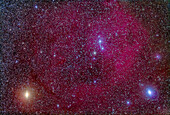
13897818 - The area of the head of Orion with the large Lambda Orionis nebulosity surrounding the star Meissa at top, with Betelgeuse (left) and Bellatrix (right) at bottom, with the Fornax Lightrack tracker and 200mm lens + Canon 5D MkII. The open cluster around Meissa is Collinder 69.
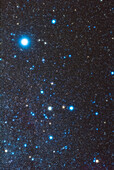
13897592 - The constellation of Canis Major, including the bright star Sirius, and below it, the open cluster M41. At bottom is the loose cluster/asterism CR 140. This is a stack of 6 x 4 minute exposures at f/2.8 with the Sigma 50mm lens and Canon 60Da at ISO 800. I shot this from Coonabarabran, Australia with the constellation straight overhead. I used the iOptron Sky Tracker. High cloud added the natural glows around stars - no filter was employed here.

13897481 - This is a telephoto lens panorama of a low and late-season display of noctilucent clouds in the north on August 7, 2022. This was the latest I had seen NLCs from my latitude of 51° N. This was taken from home in southern Alberta on a night which also featured a Kp5-level aurora show that included STEVE.

13897380 - Twilight at Red Rock Canyon area in Waterton Lakes National Park, Alberta, July 17, 2014. Mt. Blakiston is to the right, named for the first scientific explorer, Thomas Blakiston, to travel and map this area as part of the Palliser Expedition, 1858-59. The foreground has wild roses, the emblem of Alberta. This is a single frame from a time-lapse movie, taken with the Canon 5D MkII and 14mm Rokinon lens.

13876736 - Tilt shift lens image - looking up at Sykscrapers with Stars and Stripes flag in Manhattan, New York. USA.
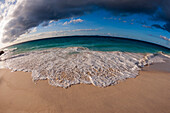
13837222 - A fisheye lens view of Indian Ocean surf surging onto a sandy tropical beach. Anse Macquereau Beach, Fregate Island, The Republic of the Seychelles.
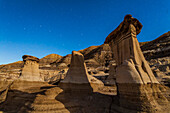
13900573 - The Hoodoos in the Red Deer River valley on Highway 10 east of Drumheller. Taken September 21, 2013 with the Canon 5D MkII and 24mm lens with a single 30-second exposure. Light from waning gibbous Moon provided the illumination.

13900504 - The dark nebula on the Cygnus-Cepheus border nicknamed the Funnel Cloud Nebula (a name provided by Alan Whitman in a 2006 Sky and Telescope article) but that is a very prominent naked eye feature to the northern Milky Way, more obvious as a dark area than the Northern Coal Sack to the south. This is a fine object for binoculars and the telephoto lens shot here provides the field of most binoculars.
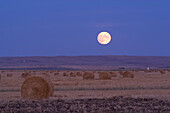
13900462 - Harvest Moon, Sept. 27, 2004, taken from near home. With Canon Digital Rebel 300D, with 20mm lens at f/13 and 1/2 sec exposure at ISO100. Minimal processing to increase contrast but Moon image is not a fake -- the balance between sky and Moon was perfect for recording Moon detail and ground without over or underexposing either.
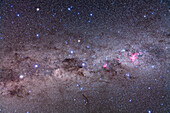
13900387 - Area of southern Milky Way containing Eta Carinae, Crux and Alpha & Beta Centaurus, taken from Atacama Lodge, Chile, March 2010, with Canon 5D MkII (modified) and Sigma 50mm lens at f/4 for stack of 4 x 6 minute exposures at ISO 800 plus stack of 4 x 6 minutes with Kenko Softon filter for star glows.
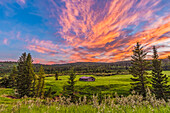
13900384 - The Symons-Noble log cabin from the 1940s in Cypress Hills Interprovincial Park, on the Saskatchewan side, at sunset on July 9, 2014. This is a stack of 6 images for a high dynamic range composite to capture the bright sky and darker foreground in one image. Taken with the Canon 60Da and 10-22mm lens.
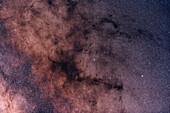
13900284 - Pipe Nebula area, field oriented equatorially, with Hutech-modified Canon 5D camera with 135mm f/2 Canon L lens at f/4 for 6 minutes each at ISO400. Stack of 4 exposures, averaged stacked. Taken from Coonabarabran, NSW, Australia, July 2006.
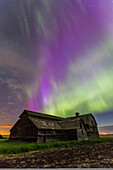
13900093 - An all-sky aurora with green and purple curtains, the night of June 7-8, 2014, starting up about 12:30 and going until dawn. This shot was near its peak, from the old barn site near home in southern Alberta. Foreground illumination is from the aurora and ambient sky -- the Moon had set. The Big Dipper is above the Barn. The purple colour is from blue scatttered sunlight hitting the red tops of the auroral curtains. This was with the 16-35mm lens at f/3.2 for 20 seconds at ISO 1600 with the Canon 6D.
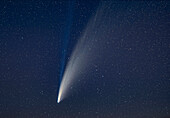
13900057 - A close-up of Comet NEOWISE (C/2020 F3) on the night of July 14/15, 2020 with a 135mm telephoto lens, and cropped in somewhat. But the field is about 10° high and the white dust and blue ion tails extend across the frame and beyond it. Some of the banding structure in the dust tail is visible.

13899821 - A 3-section panorama of a retreating thunderstorm taken from my back deck, with the Canon 5D MkII and 16-35mm Canon lens at 16mm. The storm shows mammatiform clouds and virga from falling rain. The illumination at sunset was perfect. The waxing quarter Moon is at right. Taken from southern Alberta, Canada.

13899690 - Horizon-to-zenith panorama of the northern winter sky, from Canis Major in the south just above the horizon to Cassiopeia past the zenith at the top of the frame. Capella is near the zenith above centre. The extra star at left is Mars, just 10 days past opposition, on Feb. 9, 2010, when it was just above the Beehive star cluster. Taken with Canon 5DMkII and Canon 15mm lens, at f/5 for stack of 3 exposures x 4.5 minutes each at ISO 800. Two exposures had frost on the lens, thus the big star haloes. Taken from southern Alberta, Canada.
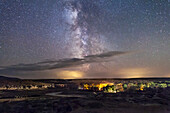
13899556 - The summer Milky Way over the campsite at Writing-on-Stone Provincial Park, Alberta, taken from the Visitor Centre RV parking area, Sept 1, 2013. This was a perfect night, warm, no wond, and no bugs. This is one frame of a 200 frame azimuth pan time-lapse with the Radian. This is 30 seconds with the 24mm lens at f/2.8 and Canon 5D MkII at ISO 3200. Yellow glows are urban light pollution from towns in Montana. Car headlights light up the sandstone formations in the Milk River Valley.
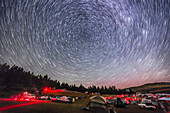
13899523 - The northern stars turn around Polaris and the North Celestial Pole in a composite of 400 images taken for a time-lapse and stacked here using Advanced Stacker Actions in Photoshop to create the comet trails effect - Using Comets 90% mode. Taken at the Table Mountain Star Party July 26, 2014 using the 14mm Rokinon lens and Canon 6D. Each exposure was 45 seconds at ISO 200.
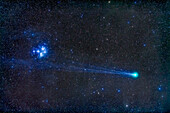
13899504 - Comey Lovejoy, C/2014 Q2, nearest the Pleiades star cluster, Messier 45, on the night of Sunday, January 18, 2015, with its blue ion tail almost passing over the cluster. This is a stack of 6 x 2 minute exposures at f/2.5 with the 135mm lens and Canon 5D MkII at ISO 1600, on the Sky-Watcher Star Adventurer tracker. Taken from City of Rocks State Park, New Mexico, Some haze was passing thru this night but this is a stack of the cleanest frames.

13899253 - The aurora of February 3-4, 2014 seen from Churchill, Manitoba at the Churchill Northern Studies Centre. I posed for my self-portrait under the stars and Northern Lights. This is a 30-second exposure at f/2.8 with the 24mm lens and ISO 2000 wth the Canon 5D MkII. Vega is setting at left, Arcturus is rising at right.
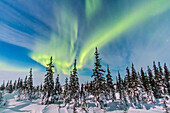
13898744 - The aurora of February 9, 2014 seen from Churchill, Manitoba at the Churchill Northern Studies Centre, in a view looking northwest from the main building over the trees, with the 10-22mm lens. This is a 10-second exposure at f/4 and ISO 800 with the Canon 60Da. Moonlight lights the landscape. Cassiopeia is at upper left.
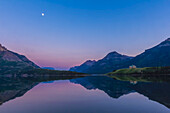
13898457 - The waxing gibbous Moon over Upper Waterton Lake in Waterton Lakes National Park, Alberta with the iconic Prince of Wales Hotel in the distance, on a calm evening with still waters, rare in Waterton. This is an HDR stack of 3 exposures with the Canon 60Da and 16-35mm lens, shot from Driftwood Beach.
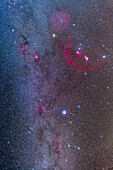
13898359 - Orion, Canis Major & Monoceros, taken from the Painted Pony Resort in New Mexico, March 14, 2013. A stack of 5 x 6 minute exposures at f/3.2 with the 35mm Canon L-series lens and 5D MkII at ISO 800, plus a layer of 2 x 4 minutes with the Kenko Softon filter for the star glows. M46, M47 and M41 clusters all visible at left and lower centre.
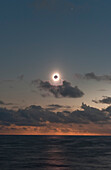
13898194 - July 21, 2009 total solar eclipse near third contact as shadow leaves the horizon and is about to hit the Sun coming toward us. Totality is about to end. Taken from Northern Cook Islands, at sea on m/s Paul Gauguin. Using 20Da and 28-105mm lens at 60mm at f/5 and ISO100. Mercury, blurred ny ship's motion, at top.
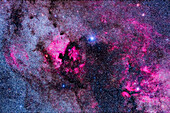
13898184 - The main complex of nebulosity in Cygnus, taken with a telephoto lens taking in a wide field of 15° by 10°.
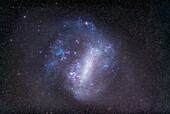
13898099 - The LMC, Large Magellanic Cloud, taken with 135mm telephoto lens for a field of view similar to binoculars. Taken from Timor Cottage, Coonabarabran, NSW, Australia, Dec 5, 2012. This is a stack of 10 x 5 minute exposures, median combined (to eliminate some satellite trails) at f/2.8 with Canon L-series 135mm lens and the modified Canon 5D Mark II camera at ISO 800. Tracked on AP 400 equatorial mount.
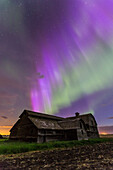
13898027 - An all-sky aurora with green and purple curtains, the night of June 7-8, 2014, starting up about 12:30 and going until dawn. This shot was near its peak, from the old barn site near home in southern Alberta. Foreground illumination is from the aurora and ambient sky -- the Moon had set. The Big Dipper is above the Barn. The purple colour is from blue scatttered sunlight hitting the red tops of the auroral curtains. This was with the 16-35mm lens at f/3.2 for 20 seconds at ISO 1600 with the Canon 6D.

13897739 - The low waxing crescent Moon in the evening sky, Sept 30, 2019, taken to demonstrate the low angle of the ecliptic in autumn. This was taken the evening after a weekend early season snowstorm. A single exposure taken with the 24-105mm lens at 105mm and Canon EOS R camera. Dynamic Contrast filter applied to the ground with ON1 Effects.
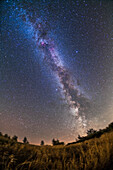
13897607 - The summer Milky Way on a clear moonless September evening, from my rural backyard in southern Alberta. This is a stack of 5 x 5 minute exposures with the 15mm f/2.8 lens and Canon 5D MkII at ISO 800, on the iOptron SkyTracker. Portrait version.
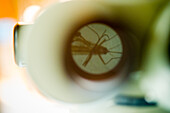
13846887 - Mosquito in the lens of a microscope
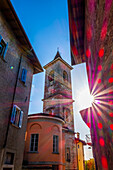
71428133 - City Road with Old House and Church Tower with Sunbeam and Lens Flare in a Sunny Day in Arzo, Ticino, Switzerland.
next page
Lens Photos – License unique travel photos ❘ lookphotos



































































































